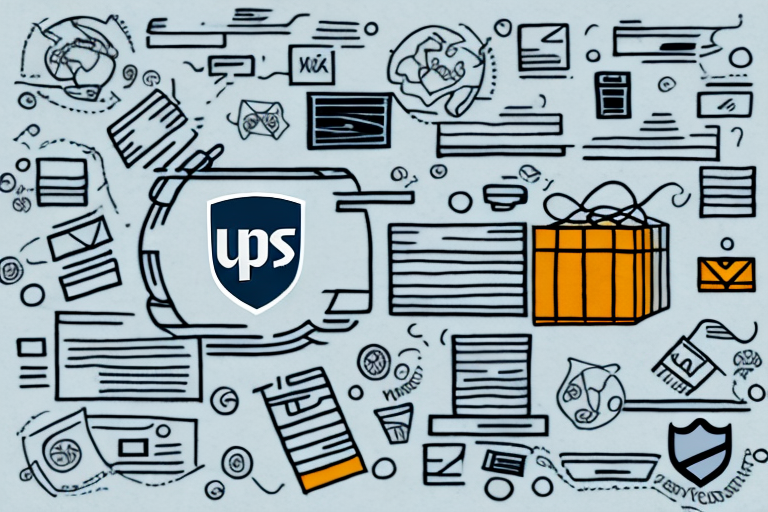Understanding Small Package Shipping Rates with UPS
As any business owner knows, shipping is a crucial part of the supply chain. For small packages, UPS offers one of the most reliable shipping services on the market. However, small package shipping rates can sometimes be confusing. Understanding how UPS determines shipping rates for small packages is key to ensuring that your business is getting the best deal. This article covers all the factors that affect small package shipping rates with UPS and provides tips and best practices to help you reduce your shipping costs.
The Importance of Small Package Shipping Rates for Businesses
Small package shipping is a vital part of the day-to-day operations of many businesses. Whether you are a small online retailer or a large corporation, getting your products to your customers in a timely and cost-effective manner can be a competitive advantage. As such, it is crucial to understand how shipping rates can impact your business's bottom line.
According to a study by UPS, shipping costs can account for up to 30% of a business's operating expenses. Therefore, optimizing shipping rates is essential for maintaining profitability.
One effective strategy to optimize your small package shipping rates is to negotiate with your shipping carrier. Many carriers offer discounts or special rates for businesses that ship frequently or in large volumes. Additionally, you can consider using a third-party logistics provider to help you find the best rates and shipping options for your business. By taking the time to research and negotiate your shipping rates, you can save your business money and improve your overall shipping operations.
How UPS Determines Shipping Rates for Small Packages
When determining shipping rates for small packages, UPS takes several factors into account:
- Package Weight and Size: Heavier and larger packages generally cost more to ship.
- Delivery Speed: Faster delivery options, such as Next Day Air, are more expensive than ground shipping.
- Origin and Destination: Shipping rates can vary based on the distance between the origin and destination.
- Packaging Options: UPS offers different packaging options, such as envelopes, boxes, and tubes, which can affect the price.
- Additional Services: Services like insurance coverage, delivery confirmation, and signature requirements can impact shipping rates.
Additionally, the type of item being shipped can influence shipping rates. UPS has specific guidelines and restrictions for shipping certain items, such as hazardous materials or perishable goods. These items may require special packaging or handling, which can increase the cost of shipping. Furthermore, the declared value of the item can affect the shipping rate, as UPS offers different levels of insurance coverage based on the declared value of the package.
Factors That Affect Small Package Shipping Rates with UPS
Several factors influence the cost of small package shipping with UPS, including:
- Package Weight and Size: Larger and heavier packages incur higher shipping costs.
- Delivery Speed: Expedited shipping options cost more than standard shipping.
- Origin and Destination: The distance between the shipping origin and destination affects rates.
- Packaging Type: Different packaging options can alter shipping costs.
- Package Value: Higher declared values may require additional insurance, increasing costs.
- Additional Services: Features like delivery confirmation or insurance add to the total shipping cost.
- Seasonal Demand: During peak seasons, such as holidays, rates may increase due to higher demand.
- UPS Discounts and Promotions: Taking advantage of available discounts can lower shipping rates.
It's also important to consider that during peak shipping periods, such as the holiday season, rates may be higher due to increased demand. Conversely, rates may be lower during slower shipping periods.
Moreover, UPS offers various discounts and promotions for small package shipping. For example, businesses that ship frequently may be eligible for volume discounts, while certain promotions may offer discounted rates for specific destinations or shipping methods. Exploring these options can help you save on shipping costs.
Ways to Reduce Small Package Shipping Costs with UPS
Reducing shipping costs is essential for maintaining profitability for many businesses. UPS offers several strategies to save money on small package shipping, including:
- Volume Discounts: Businesses that ship in high volumes can qualify for discounted rates.
- Separate UPS Account: Using a dedicated UPS account can provide access to special rates and benefits.
- Online Shipping Tools: Utilizing UPS's online tools and resources can help you manage and reduce shipping costs efficiently.
- Optimize Package Size and Weight: Reducing the size and weight of packages can lead to lower shipping costs.
- Choose the Right Packaging: Selecting appropriate packaging materials can help minimize costs and protect your products.
Another effective method is to consider alternative shipping options. For instance, UPS offers a service called UPS SurePost, a collaboration between UPS and the United States Postal Service. This service can be a cost-effective option for businesses shipping small packages that are not time-sensitive.
Finally, businesses can also negotiate shipping rates with UPS. This is especially beneficial for businesses that ship large volumes of packages. By negotiating rates with UPS, businesses can potentially save a significant amount of money on shipping costs.
Tips for Negotiating Better Small Package Shipping Rates with UPS
If you are a high-volume shipper, negotiating better shipping rates with UPS can be an effective way to reduce shipping expenses. Here are some tips for successful negotiations:
- Understand Your Shipping Needs: Have a clear understanding of your current and projected shipping volumes, package sizes, and service requirements.
- Gather Shipping Data: Present data on your shipping volumes, frequency, and patterns to demonstrate your value as a customer.
- Research Market Rates: Know the current market rates offered by other shipping carriers like FedEx, USPS, and DHL to leverage in negotiations.
- Be Flexible: Be willing to negotiate on terms beyond just price, such as delivery times, packaging options, or bundled services.
- Build Relationships: Establish a strong relationship with your UPS account representative to facilitate better communication and personalized service.
Additionally, understanding the current market rates is crucial. Researching rates offered by other shipping carriers can give you leverage in negotiations with UPS. Moreover, maintaining open communication and a positive relationship with your UPS account representative can help in negotiating better rates and receiving more personalized service.
Understanding the Different Types of Small Package Shipping Services Offered by UPS
Not all small package shipping services are created equal. UPS offers several different shipping options, each with varying delivery times and costs:
- UPS Ground: Reliable service with delivery typically within 1-5 business days, depending on the distance.
- UPS 3 Day Select: Delivers within three business days by the end of the day.
- UPS 2nd Day Air: Guarantees delivery by the end of the second business day.
- UPS Next Day Air: Provides next business day delivery to most addresses.
- UPS International Services: Offers various international shipping options with different delivery speeds and customs handling.
Additionally, UPS offers different packaging options, such as envelopes, boxes, and tubes, which can affect shipping rates based on size and weight.
Another important factor to consider when choosing a small package shipping service is the level of tracking and insurance offered. UPS provides tracking information for all packages, allowing you to monitor the progress of your shipment and ensure it arrives on time. Additionally, UPS offers insurance options to protect your package in case of loss or damage during transit.
Furthermore, consider the environmental impact of your shipping choices. UPS has committed to sustainability and offers several eco-friendly shipping options, such as carbon-neutral shipping and paperless invoicing. By choosing these options, you can reduce your business's carbon footprint and contribute to a more sustainable future.
How to Choose the Right Small Package Shipping Service for Your Business Needs
Choosing the right shipping service for your business is a critical decision that can significantly impact your operations and customer satisfaction. When selecting a service, consider the following factors:
- Package Weight and Size: Ensure the service accommodates the dimensions and weight of your packages.
- Destination: Consider both domestic and international shipping requirements based on your customer base.
- Delivery Speed: Match the delivery speed with customer expectations, balancing cost and delivery times.
- Cost of Shipping: Evaluate the shipping rates and how they fit into your budget.
- Additional Services: Services such as tracking, insurance, and signature confirmation may be important for certain shipments.
- Customer Service: Choose a carrier with reliable customer service to quickly resolve any issues that may arise.
- Reputation: Assess the carrier's reputation for reliability, package handling, and delivery success rates.
In addition to these factors, consider the level of customer service provided by the shipping carrier. You want to work with a company that is responsive to your needs and can quickly resolve any issues that may arise during the shipping process. Look for a service that offers real-time tracking and updates, as well as a dedicated customer service team that is available to answer your questions and provide support.
Finally, it's important to consider the reputation of the shipping service you are considering. Look for reviews and ratings from other businesses that have used the service, and check for any history of lost or damaged packages. Choosing a reputable shipping service can help give you peace of mind and ensure that your packages arrive safely and on time.
Best Practices for Packaging and Labeling Small Packages for Shipping with UPS
Proper packaging and labeling are critical to ensuring that your packages arrive safely and on time. Here are some best practices to follow:
- Use Appropriate Packaging: Select packaging that is suitable for the item being shipped. For fragile items, use sturdy boxes and ample padding to protect against damage.
- Secure Packages: Ensure that packages are securely sealed with strong adhesive tape to prevent them from opening during transit.
- Optimize Package Size and Weight: Use the smallest possible packaging that can safely accommodate the item to reduce shipping costs.
- Clearly Label Packages: Include clear and accurate address labels, ensuring that both the sender's and recipient's information are correct.
- Include Necessary Documentation: For international shipments, include all required customs forms and declarations to avoid delays.
- Use Proper Label Placement: Place labels on a flat surface of the package, away from seams and closures to ensure they are easily readable and scannable.
Tracking and Managing Small Package Shipments with UPS
Tracking and managing small package shipments can be straightforward with UPS's online tracking tools. Here's how you can leverage these tools:
- Online Tracking: Enter your tracking number on the UPS website or app to monitor your package's progress in real-time.
- Email and Text Notifications: Sign up for email or text notifications to receive updates on the delivery status of your packages.
- Scheduled Pickups: Use UPS's scheduled pickup service to streamline the shipping process, ensuring that your packages are collected promptly.
- Manage Returns: Utilize UPS's return management services to handle returns efficiently, improving customer satisfaction.
Additionally, UPS offers several tools for shipping management, such as UPS Business Solutions, which can help automate and optimize your shipping processes. By effectively tracking and managing your shipments, you can enhance operational efficiency and provide better service to your customers.
Common Challenges and Solutions in Small Package Shipping with UPS
Despite its reliability, small package shipping with UPS can sometimes present challenges. Common issues include:
- Package Damage: Damage can occur during transit due to mishandling or inadequate packaging.
- Lost Packages: Occasionally, packages may be lost in transit or misrouted to incorrect addresses.
- Delivery Delays: Unexpected delays can occur due to weather, transportation issues, or high shipping volumes.
To address these challenges, UPS offers several solutions:
- Insurance Coverage: UPS provides insurance options to protect the value of your packages in case of loss or damage.
- Claims Filing: If a package is lost or damaged, businesses can file a claim with UPS to seek compensation.
- Expedited Delivery Services: For urgent shipments, using expedited services can help ensure timely delivery.
Additionally, implementing best practices in packaging and labeling can help prevent these challenges from occurring in the first place. Properly packaged and clearly labeled packages are less likely to be damaged or lost, and choosing the appropriate shipping options can mitigate the risk of delays.
Comparing Small Package Shipping Rates with Other Carriers: FedEx, USPS, DHL, etc.
It is always advisable to compare shipping rates and services across different carriers to ensure that you are getting the best deal for your business. Competing carriers, like FedEx, USPS, and DHL, offer similar services but with different pricing structures and delivery options.
When comparing carriers, consider the following aspects:
- Pricing: Compare the cost of shipping services based on package size, weight, and delivery speed.
- Delivery Times: Assess whether the carrier's delivery times meet your business and customer requirements.
- Service Reliability: Review the carrier's on-time delivery rates and overall reliability.
- Additional Services: Evaluate the availability of additional services such as tracking, insurance, and signature confirmation.
- Customer Support: Consider the quality and responsiveness of the carrier’s customer support.
By evaluating your business's specific shipping needs and comparing rates and services across carriers, you can make an informed decision about which carrier best suits your small package shipping requirements. Utilizing rate comparison tools and consulting with shipping experts can further aid in selecting the most cost-effective and efficient carrier for your business.
How to Calculate Your Total Cost of Small Package Shipping with UPS
Calculating the total cost of small package shipping with UPS involves considering multiple factors:
- Package Weight and Size: Heavier and larger packages incur higher shipping costs.
- Shipping Distance: The distance between the origin and destination affects the shipping rate.
- Delivery Speed: Faster delivery options are more expensive than standard shipping.
- Packaging Type: Different packaging options can influence the overall cost.
- Declared Value: Higher declared values may require additional insurance coverage, increasing costs.
- Additional Services: Services such as tracking, insurance, and signature confirmation add to the total cost.
UPS provides several tools to help businesses calculate their total shipping costs:
- UPS Shipping Calculator: Use the UPS shipping calculator available on their website to estimate shipping costs based on package details and destination.
- UPS Rate Quotes: Request rate quotes from UPS for specific shipping needs and volumes.
- Online Account Tools: UPS offers online tools for account holders to manage and optimize their shipping costs.
By utilizing these tools and understanding the factors that affect shipping rates, businesses can accurately calculate their total shipping costs and make informed decisions about their shipping strategies. Additionally, regularly reviewing and adjusting your shipping practices based on cost calculations can lead to ongoing savings and improved efficiency.
Case Studies: Real-World Examples of Successful Small Package Shipping Strategies with UPS
Real-world examples of successful small package shipping strategies can provide valuable insights into optimizing your shipping operations. Here are a few case studies that highlight how businesses have effectively reduced shipping costs, increased efficiency, and improved customer satisfaction through their UPS shipping strategies:
Case Study 1: E-Commerce Retailer Streamlines Shipping with UPS SurePost
An e-commerce retailer faced high shipping costs and frequent delays in delivering non-urgent packages. By switching to UPS SurePost, the retailer was able to reduce shipping expenses by 15% and improve delivery times by partnering with the USPS for final delivery. This collaboration allowed the retailer to offer more competitive shipping rates to customers while maintaining reliable service.
Case Study 2: Startup Optimizes Shipping Workflow with UPS Online Tools
A startup company faced challenges in managing high volumes of small package shipments efficiently. By utilizing UPS's online shipping tools, the startup automated their shipping process, reduced manual errors, and cut shipping time by 20%. The tools enabled the startup to track shipments in real-time and manage returns seamlessly, leading to enhanced operational efficiency and customer satisfaction.
Case Study 3: Large Corporation Negotiates Volume Discounts with UPS
A large corporation with substantial shipping needs negotiated volume discounts with UPS. By committing to higher shipping volumes, the corporation secured a 10% discount on all shipments. This negotiation resulted in significant cost savings and strengthened the business relationship with UPS, enabling the corporation to receive priority service and tailored shipping solutions.
These case studies demonstrate the effectiveness of various UPS shipping strategies in different business contexts. By analyzing and implementing similar strategies, your business can achieve similar benefits in cost savings, efficiency, and customer satisfaction.
Future Trends and Innovations in Small Package Shipping with UPS
As the shipping industry evolves, UPS continues to innovate to stay ahead of the competition. Here are some future trends and innovations shaping small package shipping with UPS:
- Automation and Robotics: UPS is investing in automation and robotics to streamline warehouse operations and package handling, improving efficiency and reducing delivery times.
- Advanced Data Analytics: Utilizing big data and advanced analytics enables UPS to optimize delivery routes, predict shipping demands, and enhance overall service quality.
- Sustainable Shipping Practices: UPS is committed to sustainability, investing in electric vehicles, alternative fuels, and carbon-neutral shipping options to reduce environmental impact.
- Last-Mile Delivery Innovations: Developing innovative last-mile delivery solutions, such as drone deliveries and smart locker systems, to enhance delivery speed and convenience.
- Enhanced Tracking Technologies: Implementing more sophisticated tracking technologies, including IoT sensors and real-time visibility tools, to provide customers with accurate and timely package information.
Understanding these trends and incorporating them into your shipping operations can help your business stay competitive and leverage the latest advancements in small package shipping. Embracing innovation not only improves operational efficiency but also meets the evolving expectations of customers in the digital age.






















